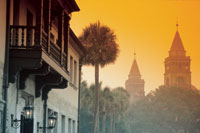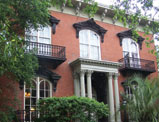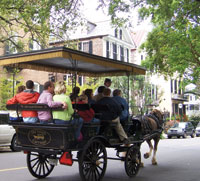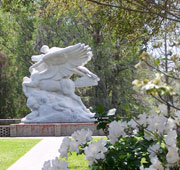A sudden thunderous blast caused me to flinch and several people to scream. For a moment, I wondered where the jarring noise came from, but the sight of re-enactors in Spanish military outfits marching around the corner of the historic fort answered my question. The sound of cannon fire is quite common at weapons demonstrations at Castillo de San Marcos National Monument in St. Augustine, Florida, the oldest and largest stone fort in the continental United States.
The 1672 fort’s Spanish guards fired similar cannon shots while fighting off a British invasion in 1702, one of many attacks the fort has withstood. The Castillo de San Marcos National Monument reveals much of the city’s past since the fortress has flown six different flags.
The 15-inch-thick outer walls of coquina help explain the fort’s durability; exhibits inside describe its uses as a Spanish fort, a British base and a prison for Native Americans.
St. Augustine, where red-roofed Spanish Colonial-style buildings are clearly visible on the 1565 town’s skyline, proudly showcases its preserved history, as did many other cities I visited on a tour up the Southeast coast with Cruises and Tours Worldwide that started in St. Augustine and ended in Myrtle Beach, South Carolina.
Clang, clang, clang went the trolley
Because Europeans chose St. Augustine as their first permanent settlement in America, historic attractions thread throughout its downtown district. The frequent appearance of orange-and-green trolleys made it easy for me to hop from one site to the other on the narrated Old Town Trolley Tours.
On the ride past several red-roofed mansions with surrounding palm trees, the driver related the story of Henry Flagler, who transformed the town into a major resort destination in the 1880s by constructing Hotel Ponce de Leon and other prominent buildings.
Two stone city gates welcomed me into the original Spanish main street at St. George Street. Shops, restaurants and the Colonial Spanish Quarter make the pedestrian street a popular walk.
The Colonial Spanish Quarters re-creates the 1740s with a quaint village filled with reproduced furnishings and docents demonstrating carpentry, blacksmithing and housework as they were practiced in the Spanish colony.
“This was a unique time in American history,” said a demonstrator sweeping a room with a broom made of palm branches. “The boys and girls all had the same chores. Things were done different here in order to survive.”
After exploring one of the oldest cities in America, I rode our tour bus to the nation’s largest urban historic-landmark district in Savannah, Georgia. The crooked branches of live oaks that reach across the streets formed a tunnel of spanish moss as I viewed one green square encircled by historic homes after another.
“The squares are our prized jewels,” said Ardis Wood, Victorian Lady Tours guide. “We have 21 squares. They are the outdoor living rooms of Savannah. Forsythe Park is our mini Central Park.”
The town’s restored homes covered in elaborate ironwork fit a variety of architectural styles, with elegant examples of Colonial, Romanesque, Victorian and Greek-revival.
One of the largest churches in the South, the Cathedral of St. John the Baptist, stands out on Lafayette Square with its gold framing, two towering steeples and huge interior of stained-glass windows and colorful murals. Wood, decked out in a reproduced early-20th-century red dress and black gloves, led me through the church and around the town with Johnny Mercer songs, Southern charm and a bit of gossip.
“We recycle our buildings, not tear them down,” said Wood. “We love our old things. In fact, we say it takes three people in Savannah to change a light bulb: one to change it and two to talk about how the old one was better.”
In the house of good and evil
Wood pointed out one house on Monterey Square with a shady past. The Mercer-Williams House Museu m was built in 1868 for songwriter and Savannah native Johnny Mercer’s great-grandfather. It came into the public spotlight with the 1994 novel Midnight in the Garden of Good and Evil and the subsequent Clint Eastwood movie of the same name, which chronicled a murder that occurred inside the red-brick house.
m was built in 1868 for songwriter and Savannah native Johnny Mercer’s great-grandfather. It came into the public spotlight with the 1994 novel Midnight in the Garden of Good and Evil and the subsequent Clint Eastwood movie of the same name, which chronicled a murder that occurred inside the red-brick house.
That evening, I dined at Lady and Sons, a restaurant started by one of the most memorable personalities in the South: Paula Deen. This Southern restaurant began as Deen’s lunch delivery service with her sons and grew in popularity because of its mouth-watering meals of fried and buttered cooking.
The next day, I visited the Magnolia Plantation and Gardens in historic Charleston, South Carolina. One of the oldest public gardens in America, it overflowed with wisteria, dogwood and 10,000 bushes of azaleas reflected in lakes and lining trails.
The 70-acre site offers a tour of the restored 1742 Drayton Hall and a tram tour of the plantation’s wetlands, lakes, forests and marshes. On the tram tour, great white herons, egrets and anhingas demonstrate that the plantation sites are in the midst of a true wilderness.
“You don’t often visit a home and gardens, and get told to watch out for alligators,” said Patrick DeLuca, naturalist for the plantation’s Wildlife Tram Tour. “We have one old alligator called Bubba, and he weighs about 700 pounds. The entire plantation is a wildlife sanctuary.”
Inside the house, a guide outlined the history of the Drayton family from the founding of the plantation in 1676 to John Drayton’s designing the gardens to lure his wife to her new home in the 1840s. The abundance of azaleas spoke to the belief that Drayton introduced azaleas to America.
Still in Charleston, I visited a more austere lifestyle at the Citadel Museum, which chronicles the history and heritage of the military college. The museum lies tucked away inside one of the many stark off-white fortress buildings of the 1842 college, with photographs illustrating the cadets’ stoic daily life.
A cannonball fired at Fort Sumter, muskets from early cadets and re-created living quarters show how the college has changed over time.
The “Holy City”
Since filmmakers used the streets of Charleston in The Patriot, it seemed fitting to tour the Colonial city by horse and buggy with Old South Carriage Co. The leisurely pace of the horses allowed plenty of time to admire the restored antebellum and pre-Revolutionary homes and churches while listening to local legends and city history. 
“We are a city of many firsts,” said Steve, guide for the Old South Carriage Co. “We have the first golf course in American history and the first fire insurance companies. Lord knows, we needed them for all the fires the city suffered. There were 13 privately owned fire insurance companies in Charleston in the 1700s, and you can still see their unique plaques on the houses.”
Charleston’s large number of churches and early tradition of religious tolerance gave it the nickname “the Holy City.” The carriage passed the 1761 St. Michael’s Church, which boasts that George Washington once worshiped there.
The role of Charleston as a religious center became even more apparent from the Ashley and Cooper rivers, where numerous steeples rise above the low cityscape.
A cruise boat covers the short distance from Charleston to Fort Sumter National Monument, where the first shot of the Civil War ended hopes of a peaceful resolution.
Though the fort looks different than when the Confederates first attacked it in 1861, 90 percent of the brickwork remains original. To help you visualize the fort in its most famous hour, guides explain the danger that was involved in an attack on a man-made island laden with gunpowder.
“Keep in mind the cannonball is a sphere of iron put into a furnace until it is glowing red-hot,” said Jasper Ray, guide at Fort Sumter. “You can see why this would be a problem. Fire and smoke erupted all over the fort. Most of the men were fighting fires more than actually fighting.”
A museum on the second floor of the fort showcases the U.S. flag that flew during the bombardment, the sword that Capt. George James held when he ordered the first shot of the Civil War and other artifacts from the battle.
At my last stop on the coast, I found that Myrtle Beach is more than just a beach destination, as I found the largest and most comprehensive collection of American figurative sculpture in the country at Brookgreen Gardens. Started by Anna and Archer Huntington in 1931, the outdoor museum follows American figurative sculpture from the 19th century to modern times, mixing natural scenery with art.
“A lot of the sculptures are surrounded by water or in their own fountains,” said Maria Streby, volunteer guide. “As you can see, the water makes a beautiful reflection on the sculptures.”
Colorful azaleas, tulips and poppies surrounding arresting statues such as the Fountain of  Muses, Nymph and Fawn and Pegasus made me feel like I’d stepped into a Greek myth. The gardens also hold a zoo, plantation ruins and an indoor sculpture display.
Muses, Nymph and Fawn and Pegasus made me feel like I’d stepped into a Greek myth. The gardens also hold a zoo, plantation ruins and an indoor sculpture display.
A guided tour uncovered more about the town’s agricultural ties with rice, indigo and turpentine farms.
“People come and see the putt-put, hotels and shopping places, and think that’s all there is to Myrtle Beach,” said Virgil Graham, Carolina Safari guide. “People don’t know the history. Myrtle’s inland was named after a notorious pirate who stole one of Blackbeard’s ships and came down here. And once he got tired of pillaging, he became a farmer here.”
Passing old plantations, cemeteries and natural wildernesses, Graham discussed how the influx of African Americans to the region brought a fresh cultural heritage to the entire Southeast coast that became known as Gullah and Geechee.
“Gullah mammies taught young whites, who started speaking Gullah, until it became the Southern accent,” said Graham. “We’d have a boring country if we didn’t have that African influence.”
All of the Southeast coast’s influences, from Gullah and antebellum to Spanish and Colonial, were visible on my tour. Although located along the same coastline, each town offers its own distinct heritage and history for visitors to experience.









